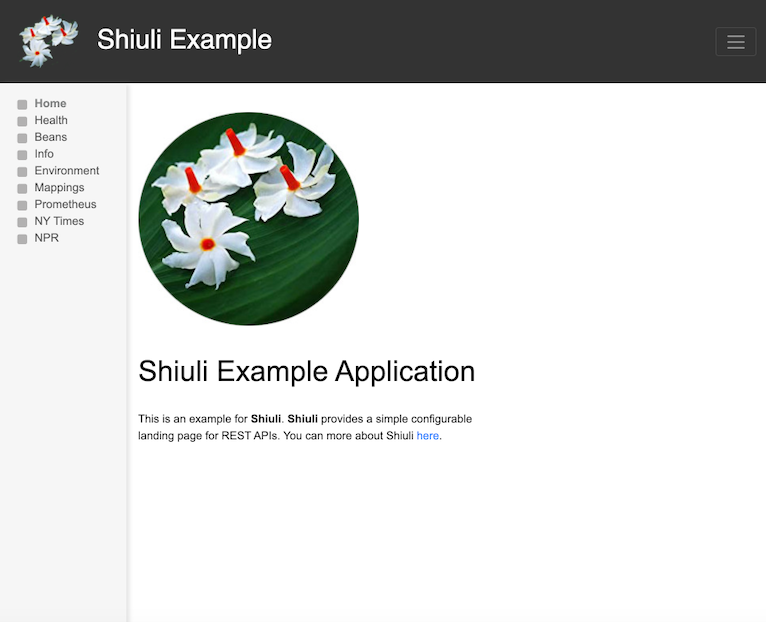Shiuli
A simple configurable landing page for REST APIs.

Shiuli provides a simple configurable landing page for REST APIs. It’s a collection of HTML, JavaScript, and CSS files packaged as a WebJars.
Maven
The current version is 0.2.0. To use Shiuli, add the following dependency to your pom.xml.
<dependency>
<groupId>com.github.indrabasak</groupId>
<artifactId>shiuli</artifactId>
<version>0.2.0</version>
</dependency>
Usage
Spring Boot picks up the content of a webjars if the jar is detected in the classpath. Please see the webjar documentation to find out more on how to configure a webjar with a Spring application.
The Shiuli landing page can be accessed at, http://<host>:<port>/
Here’s the default look and feeling of the Shiuli landing page.

Custom Configuration
You can custom configure the landing page by adding a file named shiuli.json
located under the static folder, which is under the resources directory.
your-project
|__ src
|__ main
|__ java
|__ resources
|__ static
|__ shiuli.json
The next few sections discuss ways to customize the landing page.
Title
The title can be customized by adding a title field in shiuli.json,
{
"title": "Shiuli Example"
}
Logo
The logo can be customized by adding a logo field in shiuli.json,
{
"logo": "./images/logo.png"
}
Message
The message is the content which shows up on the main viewing panel when you
first access the landing page. It can be configured in a couple of different
ways. If you want a simple text to show up, just add a text field. If you want
something elaborate, create a markdown page and specify the URL of the markdown
file in the path field.
{
"message": {
"text": "This is a simple text example.",
"path": "welcome.md"
}
}
Menu
You can add links on the navigation bar adding items in the menu field.
{
"menu": [
{
"name": "Swagger",
"endpoint": "swagger-ui.html",
"type": "html",
"embed": true
},
{
"name": "NY Times",
"endpoint": "https://www.nytimes.com",
"type": "html",
"embed": true
}
]
}
name: It’s used for giving a name the to the link which appears on the nvaigation bar.endpoint: It’s used to specify the URL of the page you would like to display. It can be relative or absolute.type: It’s used to specify the mime type of content, e.g.,json,html, ortext. It plays a role on how the content is rendered if it’s in the main viewing panel.embed: If the value istrue, the content of the URL specified in theendpointfield will be displayed in the main display panel. If it’sfalse, the content will be displayed in a separate browser window or tab.
Link
You can add links on the left panel by adding a link item in the links field.
A link item follow the same syntax as the menu item.
Here’s a simple example of a shiuli.json,
{
"title": "Shiuli Example",
"logo": "./images/logo.png",
"message": {
"text": "This is a Shiuli configured landing page of an example Spring Boot application.",
"path": "welcome.md"
},
"menu": [
{
"name": "Swagger",
"endpoint": "swagger-ui.html",
"type": "html",
"embed": true
},
{
"name": "Metrics",
"endpoint": "patra-ui.html",
"type": "html",
"embed": false
}
],
"links": [
{
"name": "Health",
"endpoint": "health",
"type": "json",
"embed": true
},
{
"name": "NPR",
"endpoint": "https://www.npr.org/",
"type": "html",
"embed": false
}
]
}
Here’s an example of Shiuli landing page after customization,

Build
- Check out the project.
- Execute the following Maven command from the parent directory:
mvn clean installOnce the build completes successfully, you should have
shiuli-1.0.0.jarin theshiuli/targetfolder.
Dependencies
Shiuli 1.0.0 depends on the following libraries:
- Bootstrap (4.5.0) is a JavaScript library provides a collection HTML design templates.
- jQuery (3.5.1) is a quintessential JavaScript library for manipulating HTML documents.
- Showdownjs (1.9.0) is a HTML converter for Markdown documents.
License
The Shiuli code is shared under the terms of Apache License v2.0.
